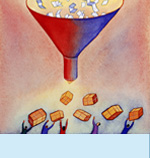| |
|
PRINTER FRIENDLY VERSION
Marketing to Kids: The ABC's of Conducting Research With Children and Teens
Recently my ten-year-old gave me a compliment, "Mom, you look beautiful
in your make-up. You know how normally your face looks all porey
and greasy? You can't see any of that when you have your make-up
on."
Kids tell it like it is. And that's the beauty of doing market research
with younger audiences. They will tell you if a product or a commercial
stinks, as well as when it's "awesome."
But interviewing kids is considerably different from research with
adults. A male colleague, who is also the father of a 14-year old
girl, tells of the time he tried to interview pre-teen girls about
their preferences for costume jewelry. "It was the longest hour
of my life," he laments, "I couldn't get any of them to talk to
me."
Moderating focus groups with kids is the closest thing I know to
being a game show host. To be successful, you need to combine Mr.
Rogers' empathy with Monty Hall's gong-ringing excitement, all the
while keeping in mind your goal of discovering what will encourage
these little folks to buy a product, join a youth organization or
watch a commercial — depending upon the objectives of the research.
It may not be for the faint of heart. Frankly, harnessing the energy
of six eight-year-old boys is always challenging. But understanding
how young audiences view your products and communications is invaluable
to successful marketing and program development.
For example, a major children's museum retained us to consult on
a range of new exhibits the museum was considering as it prepared
to double its space. We showed exhibit designs that included simulated
roller coaster and hang gliding rides to target 5th through 8th
graders, and explored their reactions. While the kids were excited
about the concepts, they also clearly expressed concerns for safety.
Would there be helmets? How about a mat underneath the hang gliding?
Our research showed that kids want to look competent and cool in
front of their friends on school field trips to the museum. If an
exhibit looks too scary, they feel anxious about showing fear in
front of their peers. Our recommendation: position the simulated
rides as the chance to try something new rather than as an all-out
thrilling experience, and emphasize the safety precautions for the
exhibit.
Structuring focus groups appropriately, establishing ground rules
and providing plenty of stimuli are critical for conducting effective
focus groups with children. Kids need structure in order to feel
safe interacting and providing their strong opinions. As any parent
knows, balancing structure with wanting to let kids be kids isn't
always easy. As the Duke of Windsor once said, "The thing that impresses
me most about America is the way parents obey their children."
Following are guidelines that we
suggest for conducting effective focus groups with children:
• Don't mix boys and girls in the same groups. Younger children
are intimidated by the opposite gender. Teens try to make dates
and act cool.
• Structure groups by school grades, rather than age, and limit
the age span within a focus group to two grades. Kids tend to act
more like their grade in school rather than their chronological
age. That means hold a group of fourth and fifth graders, rather
than nine- and ten-year-olds. Also, pay attention to how school
grades are divided in the district. Fifth graders can be in elementary
school in some districts, and in middle school in others. Don't
mix kids from entirely different school levels in the same focus
group.
• Hold smaller focus groups. Up through middle school, limit
groups to five or six children. High school groups can go up to
eight.
• Plan on conducting shorter focus groups for kids than for
adults. Forty-five minutes to an hour is appropriate for elementary
aged children. Middle school/junior high kids can handle 60-75 minutes,
while high school students can go to 90 minutes and perhaps longer
if the subject matter and activities are interesting enough.
• Speaking of activities, plan on a lot of them — and
have even more in your hip pocket. We have kids rate products on
a "cool-meter," draw pictures to communicate their ideas, act out
what they'd say to their mother to get her to buy them something
and have shouting contests to vote between different concepts. And
that's just to get us started. If an activity falls flat, be prepared
to bring out something else — and pronto.
• Explain what an opinion is at the start of the focus group.
We begin by going around and asking kids to tell their favorite
ice cream flavor or sport, so each gets a chance to talk and understand
there is no right or wrong answer.
• Make every part of the focus group as much fun as possible.
For example, when it's time to begin something new with younger
kids, ask everyone wearing green to lead the way. Direct kids to
stretch for a minute between activities, "Big stretch up for one
minute." Encourage kids to "snap your fingers if you heard what
I just said." Ask for opinions by tossing around a giant beach ball
— whoever catches the ball has to say what they think.
• Help kids to feel safe expressing their opinions. Kids are
sensitive to what others think of them. For that reason, we do a
lot of "secret voting." Encourage younger kids to write down their
vote and drop it into a top hat (we have a Cat-in-the-Hat hat).
Or have kids approach one at a time and whisper their "secret vote"
in your ear.
• Focus on visuals, particularly for younger kids. We once
had a client who wanted to test messages on first and second graders,
and sent us typed sentences a few days before the groups. The problem
was – not all first and second graders can read. We created
collages that communicated our client's messages and showed them
to the groups, getting the kids' attention and feedback on message
content.
• Be specific when asking for kids' opinions. "Is this right
for kids your age? It is more for girls or for boys? Would you ask
for this for your birthday? Tell me two good things about this.
Tell me two bad things." We have visual questionnaires that help
kids articulate these areas.
• For younger kids, sit on big pillows on the floor rather
than adult-sized tables and chairs.
• Firmly establish ground rules. Here are some of ours:
- Please talk one at a time (or we can't hear you).
- When we ask you to shout, please shout. And please be quiet when
we ask you to be quiet.
- Stay in your seat unless we ask everyone to get up.
- We want to hear from everyone.
- No punching (!)
• Use body language to manage the group.
Laugh and smile to invite the kids to participate and be creative.
Draw yourself to your full height and glare at someone who's acting
out (there's more of our parents in us than we even know).
And finally:
Have fun! Doing focus groups with kids gives you a chance to learn
how kids think, be creative, get new ideas and have a great time
while doing so. How many grown-up jobs let you do that?
NEXT ARTICLE
Jenny Schade is president of JRS
Consulting, Inc., a firm that helps organizations build leading
brands and efficiently attract and retain employees and customers. Subscribe to the free JRS newsletter on www.jrsconsulting.net/newsletter.html
© JRS Consulting, Inc. 2007
|

|
|








